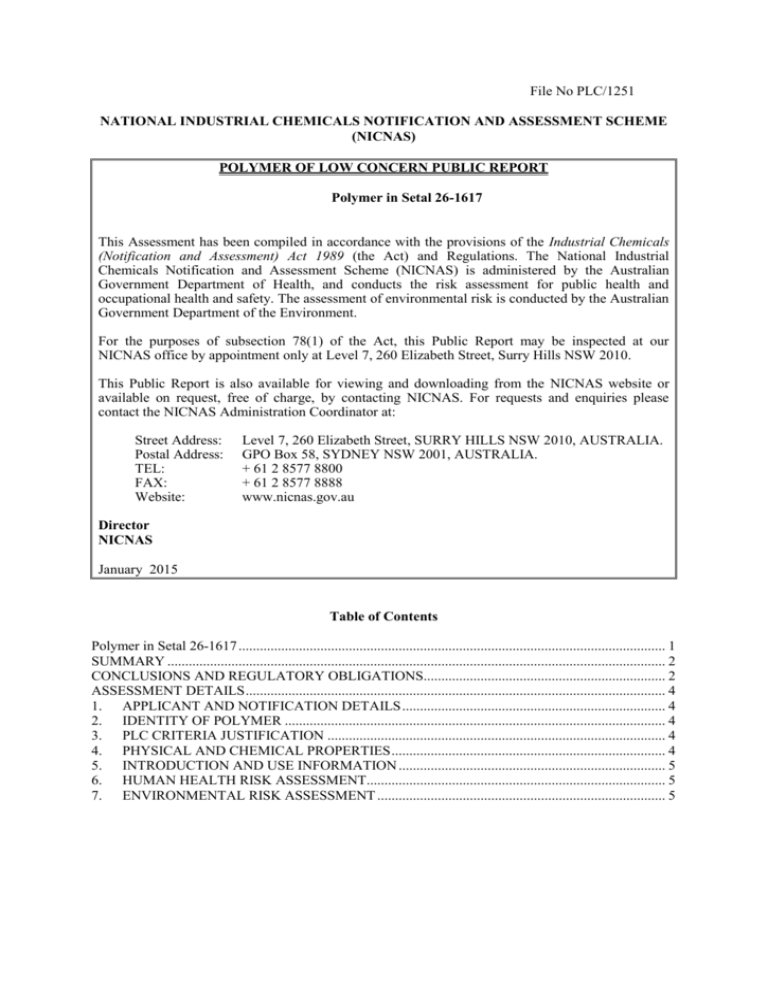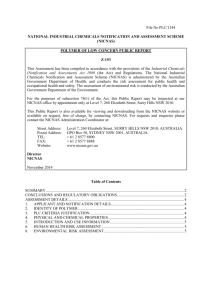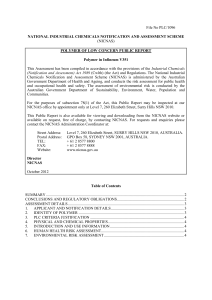PLC/1251
advertisement

File No PLC/1251 NATIONAL INDUSTRIAL CHEMICALS NOTIFICATION AND ASSESSMENT SCHEME (NICNAS) POLYMER OF LOW CONCERN PUBLIC REPORT Polymer in Setal 26-1617 This Assessment has been compiled in accordance with the provisions of the Industrial Chemicals (Notification and Assessment) Act 1989 (the Act) and Regulations. The National Industrial Chemicals Notification and Assessment Scheme (NICNAS) is administered by the Australian Government Department of Health, and conducts the risk assessment for public health and occupational health and safety. The assessment of environmental risk is conducted by the Australian Government Department of the Environment. For the purposes of subsection 78(1) of the Act, this Public Report may be inspected at our NICNAS office by appointment only at Level 7, 260 Elizabeth Street, Surry Hills NSW 2010. This Public Report is also available for viewing and downloading from the NICNAS website or available on request, free of charge, by contacting NICNAS. For requests and enquiries please contact the NICNAS Administration Coordinator at: Street Address: Postal Address: TEL: FAX: Website: Level 7, 260 Elizabeth Street, SURRY HILLS NSW 2010, AUSTRALIA. GPO Box 58, SYDNEY NSW 2001, AUSTRALIA. + 61 2 8577 8800 + 61 2 8577 8888 www.nicnas.gov.au Director NICNAS January 2015 Table of Contents Polymer in Setal 26-1617 ........................................................................................................................ 1 SUMMARY ............................................................................................................................................ 2 CONCLUSIONS AND REGULATORY OBLIGATIONS.................................................................... 2 ASSESSMENT DETAILS ...................................................................................................................... 4 1. APPLICANT AND NOTIFICATION DETAILS .......................................................................... 4 2. IDENTITY OF POLYMER ........................................................................................................... 4 3. PLC CRITERIA JUSTIFICATION ............................................................................................... 4 4. PHYSICAL AND CHEMICAL PROPERTIES ............................................................................. 4 5. INTRODUCTION AND USE INFORMATION ........................................................................... 5 6. HUMAN HEALTH RISK ASSESSMENT.................................................................................... 5 7. ENVIRONMENTAL RISK ASSESSMENT ................................................................................. 5 January 2015 NICNAS SUMMARY The following details will be published in the NICNAS Chemical Gazette: ASSESSMENT APPLICANT(S) REFERENCE PLC/1251 Nuplex Industries (Aust) Pty Ltd CHEMICAL OR HAZARDOUS INTRODUCTION TRADE NAME SUBSTANCE VOLUME Polymer in Setal 261617 No < 6 tonnes per annum USE Component of automotive coatings CONCLUSIONS AND REGULATORY OBLIGATIONS Human Health Risk Assessment Based on the assumed low hazard and the assessed use pattern, the notified polymer is not considered to pose an unreasonable risk to the health of workers and the public. Environmental Risk Assessment Based on the assumed low hazard and the assessed use pattern, the notified polymer is not considered to pose an unreasonable risk to the environment. Health and Safety Recommendations No specific engineering controls, work practices or personal protective equipment are required for the safe use of the notified polymer itself. However, these should be selected on the basis of all ingredients in the formulation. Guidance in selection of personal protective equipment can be obtained from Australian, Australian/New Zealand or other approved standards. A copy of the (M)SDS should be easily accessible to employees. Spray applications should be carried out in accordance with the Safe Work Australia Code of Practice for Spray Painting and Powder Coating (Safe Work Australia, 2012) or relevant State or Territory Code of Practice. If products and mixtures containing the notified polymer are classified as hazardous to health in accordance with the Globally Harmonised System for the Classification and Labelling of Chemicals (GHS), as adopted for industrial chemicals in Australia, workplace practices and control procedures consistent with provisions of State and Territory hazardous substances legislation should be in operation. Disposal Where reuse or recycling are not appropriate, dispose of the notified polymer in an environmentally sound manner in accordance with relevant Commonwealth, state, territory and local government legislation. Emergency Procedures Spills and/or accidental release of the notified polymer should be handled by physical containment, collection and subsequent safe disposal. FULL PUBLIC REPORT: PLC/1251 Page 2 of 5 January 2015 NICNAS Secondary Notification This risk assessment is based on the information available at the time of notification. The Director may call for the reassessment of the polymer under secondary notification provisions based on changes in certain circumstances. Under Section 64 of the Industrial Chemicals (Notification and Assessment) Act (1989) the notifier, as well as any other importer or manufacturer of the notified polymer, have post-assessment regulatory obligations to notify NICNAS when any of these circumstances change. These obligations apply even when the notified polymer is listed on the Australian Inventory of Chemical Substances (AICS). Therefore, the Director of NICNAS must be notified in writing within 28 days by the notifier, other importer or manufacturer: (1) Under Section 64(1) of the Act; if the notified polymer is introduced in a chemical form that does not meet the PLC criteria. or (2) Under Section 64(2) of the Act; if the function or use of the notified polymer has changed from [a component of automotive coatings], or is likely to change significantly; the amount of notified polymer being introduced has increased, or is likely to increase, significantly; the method of manufacture of the notified polymer in Australia has changed, or is likely to change, in a way that may result in an increased risk of an adverse effect of the notified polymer on occupational health and safety, public health, or the environment; additional information has become available to the person as to an adverse effect of the notified polymer on occupational health and safety, public health, or the environment. The Director will then decide whether a reassessment (i.e. a secondary notification and assessment) is required. (Material) Safety Data Sheet The (M)SDS of the product containing the notified polymer was provided by the applicant. The accuracy of the information on the (M)SDS remains the responsibility of the applicant. PUBLIC REPORT: PLC/1251 Page 3 of 5 January 2015 NICNAS ASSESSMENT DETAILS 1. APPLICANT AND NOTIFICATION DETAILS Applicants Nuplex Industries (Aust) Pty Ltd (ABN: 25 000 045 572) 49-61 Stephen Road Botany NSW 2019 Exempt Information (Section 75 of the Act) Data items and details claimed exempt from publication: chemical name, CAS number, molecular and structural formulae, molecular weight, polymer constituents, residual monomers/impurities, use details, and manufacture/import volume 2. IDENTITY OF POLYMER Marketing Name(s) Setal 26-1617 (contains the notified polymer at > 70% concentration in solvent solution) Molecular Weight Number Average Molecular Weight (Mn) is > 1,000 Da 3. PLC CRITERIA JUSTIFICATION Criterion Molecular Weight Requirements Functional Group Equivalent Weight (FGEW) Requirements Low Charge Density Approved Elements Only Stable Under Normal Conditions of Use Not Water Absorbing Not a Hazard Substance or Dangerous Good Criterion met Yes Yes Yes Yes Yes Yes Yes The notified polymer meets the PLC criteria. 4. PHYSICAL AND CHEMICAL PROPERTIES Appearance at 20 °C and 101.3 kPa Melting Point/Glass Transition Temp Density Water Solubility Particle Size Reactivity Degradation Products PUBLIC REPORT: PLC/1251 Liquid (product) Not available. The notified polymer is never isolated from manufacturing solution under normal conditions. 1,128 kg/m3 at 20°C Expected to be low based on the predominantly hydrophobic structure of the notified polymer. Imported in solution Stable under normal environmental conditions Carbon dioxide and water Page 4 of 5 January 2015 NICNAS 5. INTRODUCTION AND USE INFORMATION Maximum Introduction Volume of Notified Chemical (100%) Over Next 5 Years Year Tonnes 1 <2 2 <3 3 <4 4 <5 5 <6 Use The notified polymer will be used as a component of automotive coatings at < 60% concentration. The notified polymer will initially be imported and in the future may be manufactured before being reformulated into finished automotive coatings in Australia. The finished automotive coatings will only be used in industrial settings and will be applied by spray application. 6. HUMAN HEALTH RISK ASSESSMENT No toxicological data were submitted. The notified polymer meets the PLC criteria and is therefore assumed to be of low hazard. The risk of the notified polymer to occupational and public health is not considered to be unreasonable given the assumed low hazard and the assessed use pattern. 7. ENVIRONMENTAL RISK ASSESSMENT No ecotoxicological data were submitted. Polymers without significant ionic functionality are generally of low concern to the environment. The notified polymer will be imported into Australia as finished automotive coatings. However, the notified polymer may be manufactured and reformulated into finished automotive coatings in Australia in the future. During the reformulation process, up to 2% of the finished automotive coating may be released as waste from the cleaning of pumps, lines, and mixing vessels. Solvent will be used to flush equipment and the washings will be collected and re-used. Non-usable solvent, containing paint wastes and the notified polymer, are disposed of in accordance with state/ territory/Australian hazardous waste standards. Empty steel drums will be sent to an approved drum reconditioner where the liquid resin will be collected and disposed of accordance with state/ territory/Australian hazardous waste standards. The finished automotive coatings will only be used in industrial settings and will be applied to automotive and auto-body parts using a High Volume Low Pressure (HVLP) spray gun in spray booths. The main release during use is expected to be from overspray. The spray booths are designed specifically to remove and capture any aerosols and vapours arising from overspray. The wastes from overspray are anticipated to be intercepted by spray booth filters, and disposed of to landfill or according to state, territory and local regulations. Given the engineering controls in place, direct environmental release of the notified polymer from use is not expected. Solid wastes including masking materials are expected to be disposed of to landfill. Residues of the notified polymer that remain in the product containers are anticipated to be collected and disposed of to landfill. Discarded end-use articles containing the notified polymer in the cured coating film will be disposed of to landfill, or recycled for metal reclamation which will entail thermal decomposition of the coating to form oxides of carbon and water. In landfill, the notified polymer will be present as a cured solid film and will be neither bioavailable nor mobile. Therefore, the notified polymer is not expected to pose an unreasonable risk to the environment based on its assessed use pattern. PUBLIC REPORT: PLC/1251 Page 5 of 5









